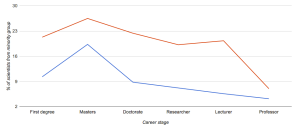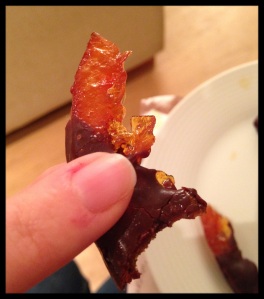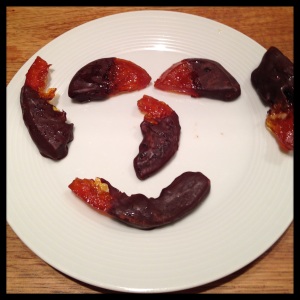
BBC Newsnight coverage of BICEP2 results. Photograph: BBC via Guardian
Last week the global physics community celebrated the announcement of experimental results that reveal the very origins of our universe. While major news and science outlets focused on the discovery itself, a Daily Mail columnist inexplicably focused instead on the gender and race of two of the scientific experts invited onto BBC’s Newsnight.
The findings announced by the BICEP2 team appear to show a glimpse of the physics very shortly after the Big Bang and provide evidence for both gravitational waves and cosmic inflation, which caused ripples in the very fabric of space…! How do I know this? Not from watching Star Trek, I assure you. Nature came to my assistance. Given that Einstein predicted the existence of gravitational waves in 1916, Linde has waited 31 years for evidence of inflation* and that the results from BICEP2 appears to show both as well as being consistent with the so-called “Grand Unifying Theory”… talk has already turned to Nobels.
With the prospect of having evidence of the first moments of the universe, BBC Newsnight, rightly judged the scientific breakthrough as “newsworthy” and joined the international coverage. They produced this segment, which includes a background description by Dr. Chris Lintott of the University of Oxford and The Sky at Night, an interview with one of the BICEP2 team and two studio scientists: International expert in the field and researcher on the European Planck project, Dr Hiranya Peiris, Univeristy College London (UCL) & award-winning science communicator and The Sky at Night co-host, Dr Maggie Aderin-Pocock, also UCL.
It will come as no surprise to some, that the international excitement generated by the discovery ended at a Daily Mail columnist’s front door. Far from being inspired (or inspiring) in the face of astonishing scientific endeavour, “Ephraim Hardcastle” (a pseudonym later disclosed to be Peter McKay) posted a bizarre swipe at BBC Newsnight’s coverage:
“Newsnight’s Guardian-trained editor, Ian Katz, is keen on diversity.
So, two women were invited to comment on the report about (white, male) American scientists who’ve detected the origins of the universe – giggling Sky at Night presenter Maggie Aderin-Pocock and Sri-Lanka-born astronomer Hiranya Peiris.” ~ Ephraim Hardcastle aka Peter McKay

The Daily Mail’s column by Ephraim Hardcastle. [N.B. Clicking provides traffic and income to online media. The article can be see on the Daily Mail website HERE.]
- The implication that the two studio scientists were invited BECAUSE of their gender and/or race.
- The trivialising of the female scientists by use of “women” compared with the language used for men, sorry, “American scientists”.
- The erroneously assumed racial & gender background (white, male) of the experimental team, juxtaposed against the studio scientists.
- That the birth place of Dr Hiranya Peiris is of ANY relevance whatsoever.
The notion that the scientists were invited to participate in the communication of complex scientific discussion within BBC newsrooms BECAUSE they were women and BECAUSE they were ethnic minority women was dispatched with quickly and expertly by Professor David Price, Vice-Provost for Research at UCL. In an open letter to the Editor of the Daily Mail, he highlighted the stellar credentials of Drs Peiris and Aderin-Pocock. Also pleasing was the quick and nicely-pitched public display of solidarity by fellow UCL physicist, Jon Butterworth, over at the Guardian. The defence was backed up on Friday by the Royal Astronomical Society. The truth is that these scientific experts weren’t invited to participate in Newsnight BECAUSE they are BME women. One is an international expert in the field and the other a highly qualified scientist with expertise in space science communication. They were invited for their expertise. That this has to be defended to the editor of a national newspaper in modern Britain is nothing short of depressing.

The percentage of girls studying physics at A-level from IOP report It’s Different for Girls

Academic career progression in physics for under-represented groups (red = women; blue = BME). [Plotted using The interactive data provided by The Royal Society (data on other STEMM subjects also available).]
In light of that, a “diversity agenda” at the BBC, by which I mean mindfully improving the representation of typically under-represented groups rather than regressing to unconscious bias should be supported.
McKay’s comments defend the hegemony of social privilege by belittling the selection of studio scientists as nothing more than fulfilling a diversity quota. Highlighting “otherness”, rather than excellence, as your defining factor. Achievements disregarded with a swipe of arrogant entitlement, as the expert is reduced to a label, a colour, an “other”. And though, as in this case, defence may be at the ready (though this will often be met with claims that you are being “over-sensitive”), the poison is already in the ether; “You’re only there because you’re a woman… You’re not actually as good as your male peers… They only wanted a minority face on the screen to satisfy a quota… Look, she wasn’t even born in Britain”… The undertone is to challenge your voice and undermine your position. Silence of bystanders in the face of this, magnifies it’s affect. That’s why I think it’s important to strongly object when you see the thinly veiled disguise of bigotry using diversity as a dirty word; the icing on a cake of spite:

The (inadequate) response from the Daily Mail columnist. With thanks to James Elder (@jamesofputney) for help providing this snippet.
I encourage you sign this petition initiated by UCL asking the Daily Mail to apologise that they allowed such an irresponsible message with xenophobic & sexist undertones, which perpetuate privilege and stereotypes, to be published. This, I think, is one small way to show support to Dr Hiranya Peiris and Dr Maggie Aderin-Pocock and to say, “Enough!” to the Daily Mail. The message we should be giving young men & women, BME communities, schools, parents and anyone that will listen is that science is for everyone. That diversity is not a dirty word.
“I deeply pity the sort of person who can watch a report about ground-breaking news on the origins of the universe and everything in it, and see only the gender and skin colour of the panellists.” ~ Dr. Hiranya Peiris, Reader in Astronomy, University College London
* To recover from the unsavoury antics of Daily Mail columnists, enjoy the heart-warming response of the physicist who had predicted the inflation model, Prof. Andrei Linde and his wife, Prof. Renata Kallosh (whose research applies inflation to string theory), captured on video, as they are told of the experimental results. Surprised by a member of the BICEP2 team, Dr Chao-Lin Kuo, Prof. Kallosh’s response, “Discovery!” was a beautiful thing. Moments of success are hard won in research science and ones of this magntitude, are once-in-a-lifetime stuff.





